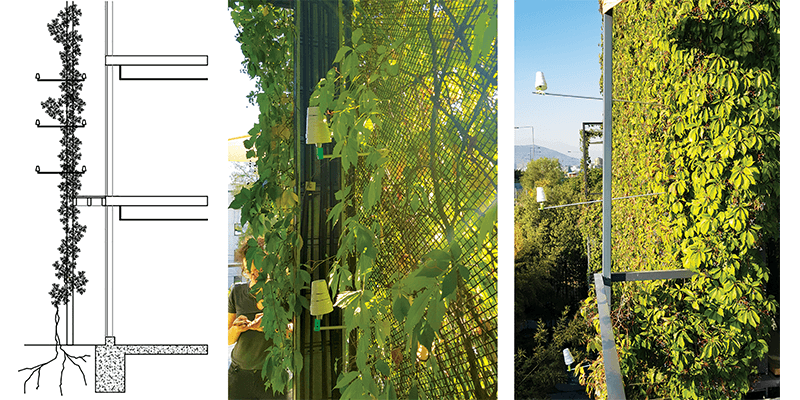Downloads
DOI:
https://doi.org/10.7480/jfde.2020.2.5109Keywords:
Green façade, green screen façade, thermal comfortAbstract
Green screen façades (GSF) remain an unexplored field of study in warm-summer climates with Mediterranean conditions.
This research aims to establish whether or not these thermal comfort façade systems are worth developing in cities with dry summers and a high range of thermal oscillation. A comparative study of four buildings´ green screen façades in Santiago de Chile was carried out, with different orientations and plant species, both in type and state of maturity.
Temperature and relative humidity outside and inside the cavity were measured during summer days. It was observed that, during the day, interior relative humidity was higher while the temperature was lower, reverting this behaviour during the afternoon and night. This result accounts for the existence of two different daily periods: passive cooling through evapotranspiration in the presence of solar radiation - reaching up to an 8°C temperature reduction and a 30% increase of the relative humidity - and passive heating in its absence.
The results show that the determining parameters in the behaviour of a green screen façade in a temperate-warm climate are, first, the orientation of the façade, and second, the density of foliage. Regarding orientation, it was also found that the sun exposure was directly proportional to the performance of a green screen façade.
How to Cite
Published
Issue
Section
License

This work is licensed under a Creative Commons Attribution 4.0 International License.
Authors or their institutions retain copyright to their publications without restrictions.
References
Allan, S., & Kim, H. (2016). A study of workflow for simulations of vertical greenery systems. Architecture Research(6), 142-153. doi:10.5923/j.arch.20160606.02
Cameron, R., Taylor, J., & Emmet, M. (2014). What’s ‘cool’ in the world of green façades? How plant choice influences the cooling properties of green walls. Building and Environment(73), 198-207. doi:10.1016/j.buildenv.2013.12.005
Carpenter, C., & Sikander, E. (2015). Green building envelopes - Moisture safety in ventilated light- weight building envelopes. 6th International Building Physics Conference , IBPC 2015. Energy Procedia(78), 458-464. doi: 10.1016/j.egypro.2015.11.179
Chen, Q., Li, B., & Lui, X. (2013). An experimental evaluation of the living wall system in hot and humid climate. Energy Build(63), 298-307. doi:10.1016/j.enbuild.2013.02.030
Cheng, C., Cheung, K., & Chu, L. (2010). Thermal performance of a vegetated cladding system on face walls. Build Environment(45), 1779-1789. doi:10.1016/j.buildenv.2010.02.005
Cifuentes, L., & Mesa, F. (2008). Cambio Climático: consecuencias y desafíos para Chile. Santiago: Universidad Católica.
Dahanayake, K., Chow, C., & Hou, G. (2017). Selection of suitable plant species for energy efficient Vertical Greenery Systems (VGS). Energy Procedia(142), 2473-2478. doi:doi:10.1016/j.enbuild.2017.03.066
Den Dubbelden, K., & Oosterbeek, B. (1995). The availability of external support affects allocation patterns and morphology of herbaceous climbing plants. Functional Ecology(9), 628-634. doi:10.2307/2390154
Djedjig, R., Bozonnet, E., & Belarbi, R. (2015). Analysis of thermal effects of vegetated envelopes: Integration of a validated model in building energy simulation program. Energy and Building(86), 93-103. doi:10.1016/j.enbuild.2014.09.057
Hoelscher, M., Nehls, T., Jänicke, B., & Wessolek, G. (2016). Quantifying cooling effects of facades greening: shading, transpiration and isulation. Energy and Buildings(114), 283-290. doi:10.1016/j.enbuild.2015.06.047
Hunter, A., Williams, R., Rayner, J., Aye, L., Hes, D., & Livesley, S. (2014). Quantifying the termal performance of Green façades: a critical review. Ecological Engineering(67), 103-113. doi:10.1016/j.ecoleng.2013.12.021
Manso, M., & Castro-Gómez, J. (2016). Thermal analysis of a new modular system for green walls. Journal of Building Engineering(7), 53-62. doi:10.1016/j.jobe.2016.03.006
Mohamed, S., & Magdy, N. (2012). Green Facades as a New Sustainable Approach Towards Climate Change. Energy Procedia(18), 507-520. doi:10.1016/j.egypro.2012.05.062
Pan, L., & Chu, L. (2016). Energy saving potentical and life cycle environmental impacts of a vertical greenery system in Hong Kong: A case study. Building and Environment(96), 293-300. doi:10.1016/j.buildenv.2015.06.033
Pan, L., Wei, S., & Chu, L. (2018). Orientation effect on thermal and energy performance of vertical greenery systems. Energy and Buildings(175), 102-112. doi:10.1016/j.enbuild.2018.07.024
Pan, L., Wei, S., Lai, P., & Chu, L. (2020). Effect of plant traits and substrate moisture on the thermal performance of different plant species in vertical greenery systems. Building and Environment(175). doi:10.1016/j.buildenv.2020.106815
Peel, M., Finlayson, B., & McMahon, T. (2007). Updated world map of the Köppen-Geiger climate classification. Hydrology and Earth System Sciences Discussions, 11, 1633-1644. doi:10.5194/hess-11-1633-2007
Pérez, G., Coma, J., Sol, S., & Cabeza, L. (2017). Green facade for energy savings in buildings: The influence of leaf area index and facade orientation on the shadow effect. Applied Energy(187), 424-437. doi:10.1016/j.apenergy.2016.11.055
Pérez, G., Rincón, L., Vila, A., González, J., & Cabeza, L. (2011). Behaviour of green façades in Mediterranean Continental Climate. Energy Conversion and Management(52), 1861-1867. doi:10.1016/j.enconman.2010.11.008
Romero, H., Irarrázaval, F., Opazo, D., Salgado, M., & Smith, P. (2010). Climas Urbanos y Contaminación atmosférica en Santiago de Chile. EURE(36), 35-62. doi:10.4067/S0250-71612010000300002
Safikhani, T., Megat, A., Remaz, D., & Baharvand, M. (2014). A review of energy characteristic of vertical greenery systems. Renewable and Sustainable Energy Reviews(40), 450-462. doi:10.1016/j.rser.2014.07.166
Schettini, E., Blanco, I., Campiotti, C., Bebbiani, C., Fantozzi, F., & Vox, G. (2016). Green control of microclimate in building. Agriculture and agricultural science procedia(8), 576-582. doi:10.1016/j.aaspro.2016.02.078
Šuklje, T., Medved, S., & Arkar, C. (2016). On detailed thermal response modeling of vertical greenery systems as cooling measure for buildings and cities in summer conditions. Energy(115), 1055-1068. doi:10.1016/j.energy.2016.08.095
Susorova, I., Angulo, M., Bahrami, P., & Stephens, B. (2013). A model of vegetated exterior facades for evaluation of wall thermal performance. Building and Environment(67), 1-13. doi:10.1016/j.buildenv.2013.04.027
Yang, F., Yuan, F., Zhuang, Z., & Yao, J. (2018). Summertime thermal and energy performance of a double-skin green facade: A case study in Shanghai. Sustainable Cities and Society(39), 43-51. doi:0.1016/j.scs.2018.01.049
